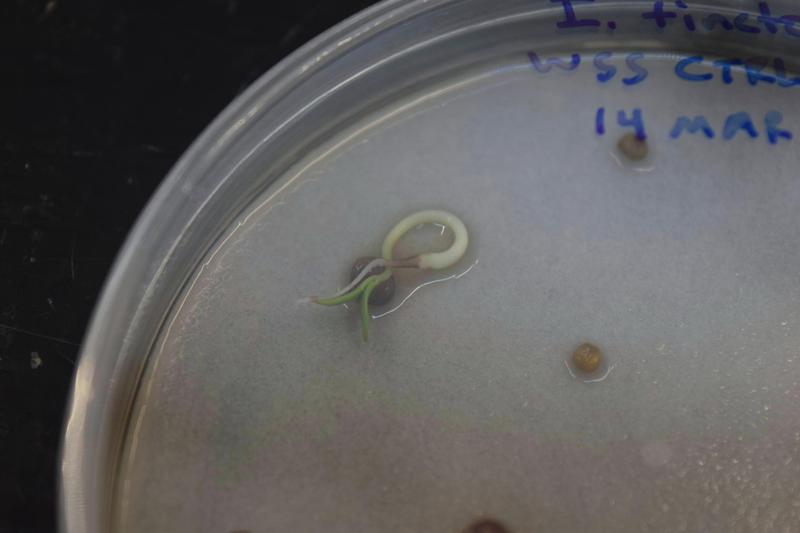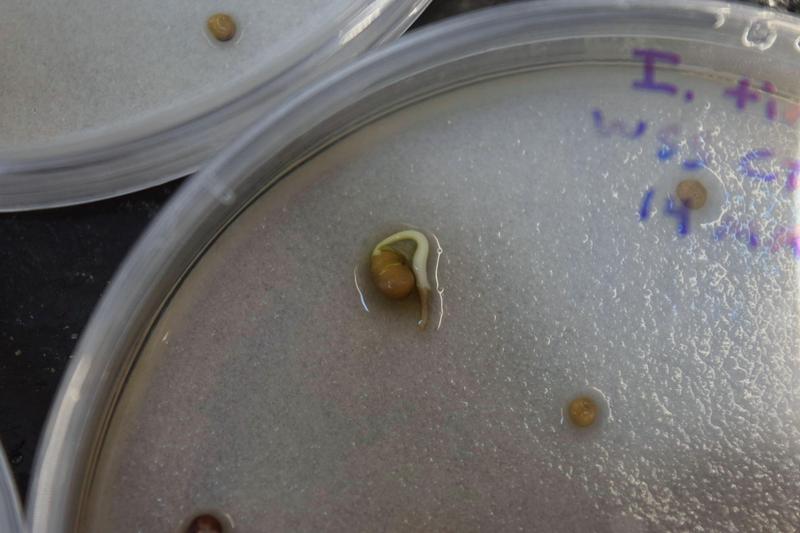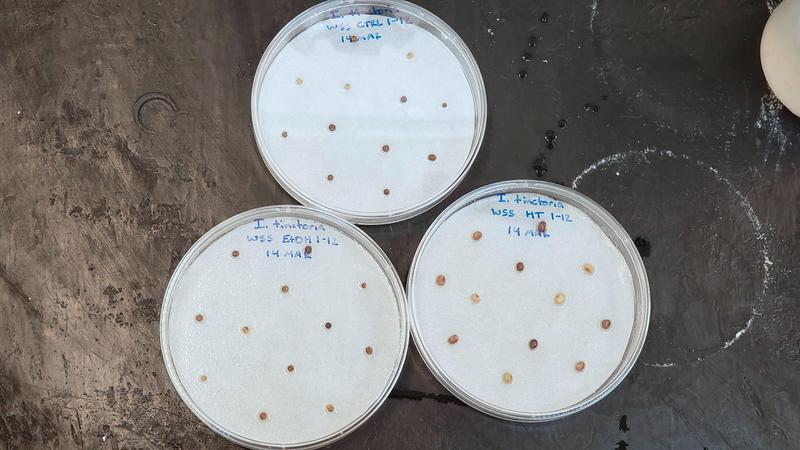Indigofera tinctoria
Source of the blue dye *indigo*.
Propagation
Germination
| media | germination | temperature °C | note | reference |
|---|---|---|---|---|
Tinctoria seeds show physical dormancy. Unless scarified, they exhibit very low/slow germination.[1][2]
In one study, optimized scarification by rubbing lightly with sandpaper for 5 minutes resulted in the highest germination (67%) compared to soaking in hot water (20%) or cold water (27%). Soaking in sulfuric acid for 3 and 6 minutes resulted in 3% germination and no seeds germination when soaked for 9 minutes.[3]
Scarification by soaking in 95% ethanol for 15 minutes resulted in 65% germination. Either 10 minutes or 20 minutes was significantly worse at 15% and 40%, respectively. Soaking in 98% sulfuric acid for 15 minutes has the highest germination at 80%. Either 10 minutes or 20 minutes was worse at 45% and 25%, respectively. Twenty-five minutes resulted in zero germinations, likely due to damage to the seed. Seed without pretreatment had a 6.7% germination rate. Other treatments like IAA, GA3, cow’s urine, cow’s milk, and coconut water had variable to mild improvements to germination rate compared to the control.[1]
In a later study, five and ten-minute soaks in concentrated sulfuric acid had 1% and 0% germination. A “quick dip” in the same acid resulted in 76% germination, the highest noted in the study. Mechanical and thermal scarification as well as lower concentrations of sulfuric acid had worse germination rates, with a maximum of 10%, 28%, and 61%, respectively. No significance or deviation values were given, however.[2]
Yet another study found 87-95% germination in tinctoria seeds scarified with 95% sulfuric acid treatment with no statistically significant variation between 15 and 60 minutes. Similar germination (93%; NS difference) was seen with physical scarification by removal of a small section of integument with a scalpel.[4]
Other Indigofera species respond heterogeneously to physical scarification (rubbing with sandpaper) and boiling water immersion (put into boiling water and allowed to cool naturally). Cryptantha, brevicalyx, arrecta, spicata (2 accessions), vohemarensis, and trita generally respond favorably to either treatment. Cryptantha and spicata respond best to physical scarification while the remainder perform best with boiling water treatment.[5]
Similarly, in glandulosa, 75% germination was noted after soaking in concentrated sulfuric acid for 10 minutes compared to 0% in control seeds without pretreatment.[6]
Zollingeriana seeds soaked overnight in 100°C water resulted in an average of about 60% germination with only moderate variation between seed pod harvest colors.[7]
The optimal germination temperature for tinctoria lies somewhere between 25-35°C (nonlinear correlation) with the highest rate (53%) at 35°C.[4]
Vegetative
In-Vitro
| basal media | supplements | source | target | note | reference |
|---|---|---|---|---|---|
Cultivation
| Planting density (m-2) | inter-row space (cm) | intra-row space (cm) | note | reference |
|---|---|---|---|---|
Greater shading at 50%, 75%, and 90% reduced root mass in tinctoria. Non-significant heterogeneity was preset in many parameters. Leaf area increased with decreasing light levels.[8] 1
Similarly, the number of leaves, the number of leaf nodes, and the fresh weight were maximized at 100% light levels (63,200 lux, max), compared to 50% and 25%. Indigo concentration was inversely correlated with light intensity, reaching a maximum of 6.52 mg/l2 at 25% intensity though total indigo extract weight remained remarkably unchanged between light intensities.[9]
Harvest
Yield
| product | source | yield per season (kg/ha) | note | reference |
|---|---|---|---|---|
| product | source | yield per plant | note | reference |
|---|---|---|---|---|
Soilless
Soil
| soil type | pH | C-content % | precipitation | temperature (°C) | altitude (m) | note | reference |
|---|---|---|---|---|---|---|---|
Fertilization
| type | rate | time | note | reference |
|---|---|---|---|---|
Tinctoria responds well to mineral fertilizers. Dry mass (leaf, stem, root, total) and wet mass (leaf, stem, root, total) dose-dependently increased with NPK fertilization.[10] 3
Similarly, organic fertilization in the range of 200-400 grams with 10 grams of mycorrhizal inoculant per plant was able to increase root/shoot fresh weight, root biomass, and the number of leaves significantly. The organic fertilizer was made (details not shown) from dye waste tinctoria.[11]
The optimal NPK ratio for maximizing dye yield in tinctoria is 43:23:34 (mol %). Leaf yield is more sensitive to NPK variation than dye concentration.[12]4 In the more traditional weight % base of N:P2O5:K2O this would be about 42:43:16.
Temperature
Lighting
| fixture type | photoperiod | illumination | note | reference |
|---|---|---|---|---|
Pests
Ecology
Morphology
| character | measurement | unit | notes | reference |
|---|---|---|---|---|
Indigofera is divided into four clades: paleotropical, pantropical, cape, and tethyan. Tinctoria is in the pantropical clade along with arrecta, astragalina, austalis, decora, heterantha, hirsuta, suffruticosa, zollingeriana, and about 300 other species. All species in the pantropical clade produce the indican glycoside though that is not exclusive to the clade.[13][14]
Roots
Stem
Leaves
Inflorescence
Seeds
Phytochemistry
| compound | source | concentration (mg/g dry weight) | note | reference |
|---|---|---|---|---|
Infraspecific Variation
Biosynthesis
Distribution
Timecourse
Improvement
| trait | improvement status | reference |
|---|---|---|
Identification
| variety | description | reference |
|---|---|---|
Inheritance
Methods
| type | note | reference |
|---|---|---|
History & Society
Work Log
18 Mar 2022
The first germination from trial 1 has progressed to hairy-root development.
17 Mar 2022
The first germination is from the control group.
14 Mar 2022
Started 3 groups of 12 seeds (WSS) each: 15-minute immersion in boiling water, 15-minute treatment with 95% ethanol, and a 15-minute soak in water (control).
I think the heat treatment was a little excessive. The seeds were expanded immediately upon treatment and the water was darkened. I should try a 1-5 minute immersion if this trial is unsuccessful.
11 Mar 2022
-
Study was not designed to compare light intensity at the same time period. Also, study has obvious calculation, reporting, and grammatical errors. ↩
-
Indigo concentration shows as mg/l with no indication of how that related to plant weight. Study has obvious calculation, reporting, and grammatical errors. ↩
-
There is no indication of the fertilizer application rate. Study has obvious calculation, reporting, and grammatical errors. ↩
-
Actual recipe used for cultivation cannot be found. ↩


